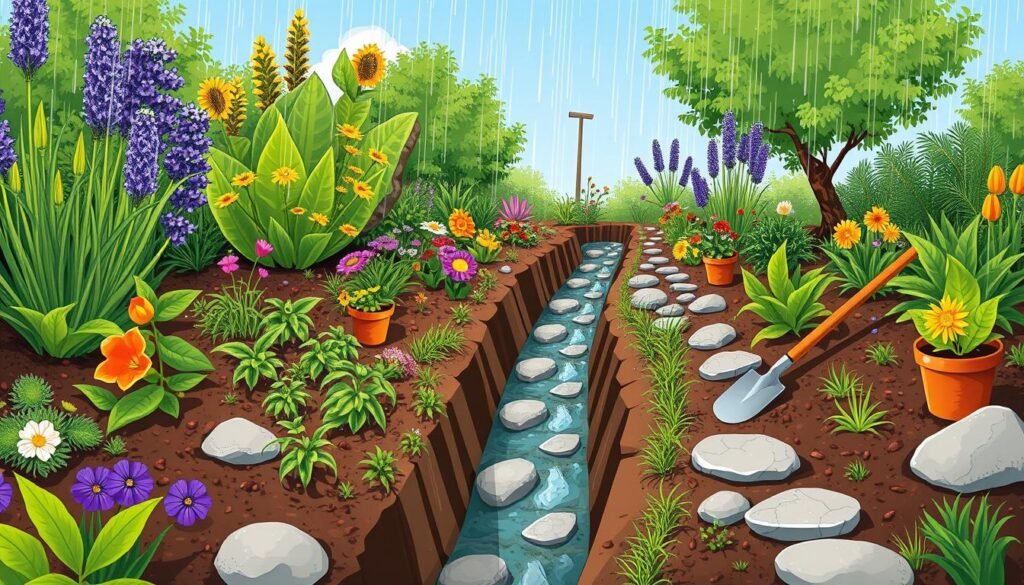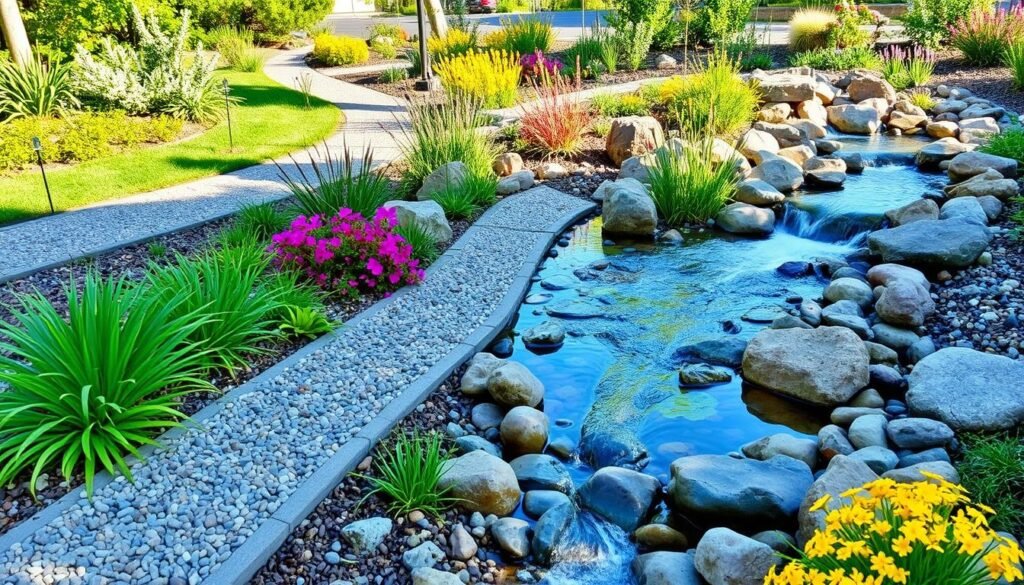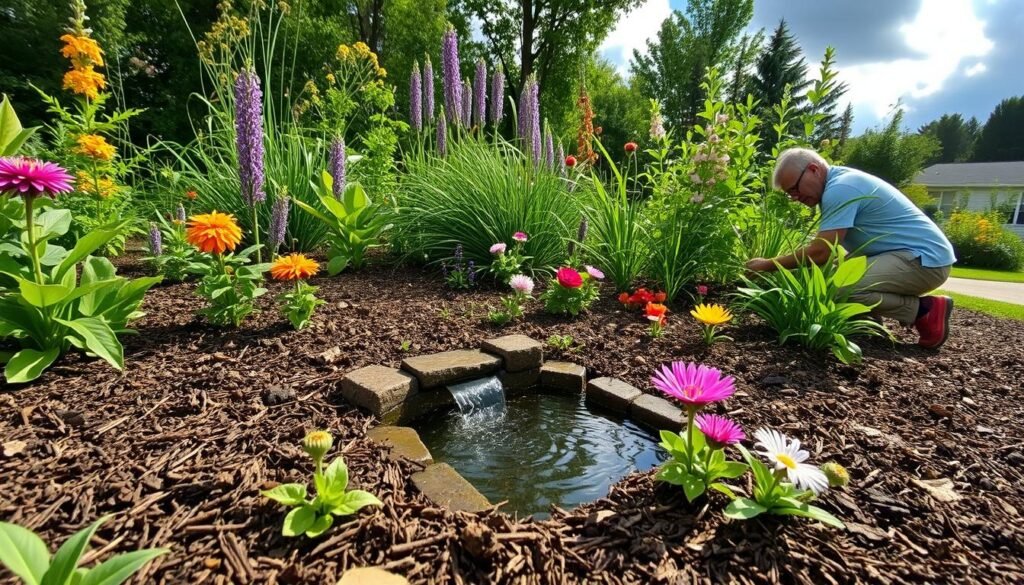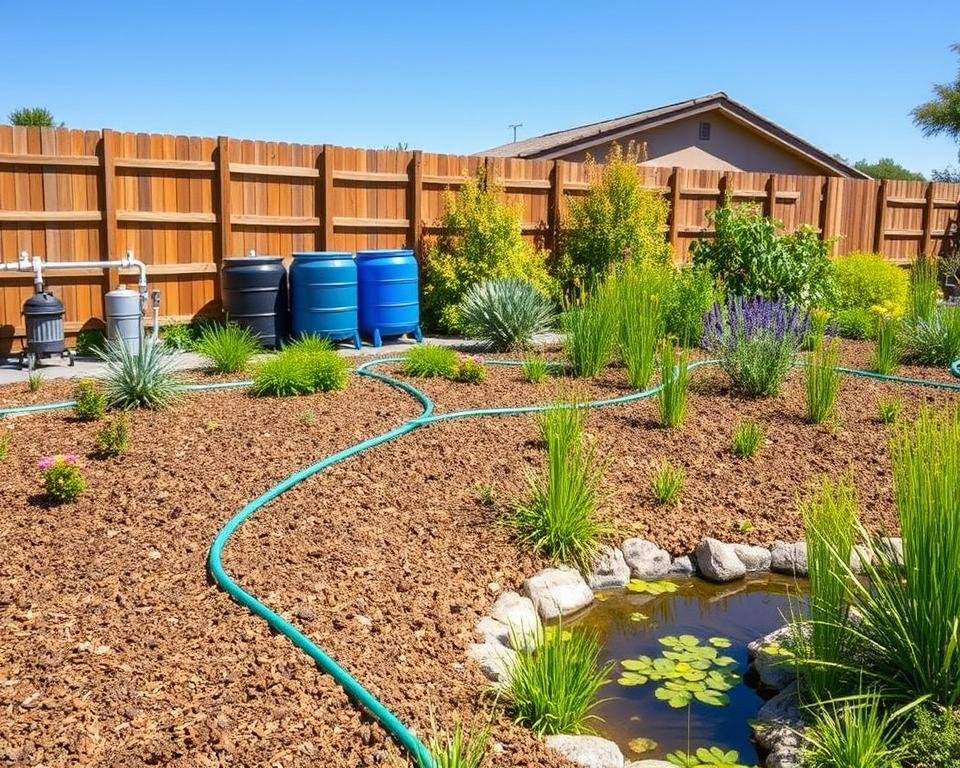Ever thought about how you can help the environment in your own yard? A rain garden might be the answer. But what is a rain garden, and how does it help? Let’s explore this natural solution for managing stormwater.
What is a Rain Garden and Why Should You Build One?
A rain garden is a landscaping feature designed to manage stormwater runoff. It’s a shallow depression in the ground, placed to collect rainwater from roofs and driveways. This excess water is absorbed, playing a key role in sustainable landscaping and green infrastructure.
Understanding the Benefits of Rain Gardens
Rain gardens bring many benefits, making them vital for water conservation and environmental protection. They help:
- Recharge groundwater supplies by allowing water to slowly infiltrate the soil
- Reduce the risk of flooding and erosion by minimizing stormwater runoff
- Filter out pollutants, such as heavy metals, oils, and nutrients, from the water
- Provide habitat and food sources for local wildlife, including pollinators
- Enhance the aesthetic appeal of your landscape with vibrant, native plants
How Rain Gardens Help Manage Stormwater Runoff
Stormwater runoff is a major environmental concern, carrying pollutants into waterways and causing flooding. Rain gardens intercept and absorb this excess water. They prevent it from rushing into storm drains or directly into streams and rivers. By slowing down water flow and allowing it to seep into the ground, rain gardens replenish groundwater and ease the burden on municipal stormwater systems.
Choosing the Ideal Location for Your Rain Garden
Choosing the right spot for a rain garden is key to its success. When picking a rain garden location, several factors are important. The land’s slope, soil type, and distance to downspouts or water sources are crucial. These elements help determine the best site selection for your rain garden.
First, observe your yard’s drainage patterns. Watch how water moves during heavy rains. Identify where water tends to collect or pool. These spots are ideal for a rain garden since they naturally collect and filter stormwater runoff.
Soil type is also critical. Rain gardens do best in soils that drain well and absorb water quickly. This prevents puddles. By choosing the right soil, your sustainable landscaping feature will manage stormwater management effectively.
Position your rain garden near downspouts or other water sources. This includes paved areas or roofs. This setup allows the garden to capture and filter water, aiding in stormwater management.
By considering these factors and picking the perfect spot, you’ll create a stunning and practical addition. It will not only beautify your property but also contribute to sustainable landscaping and stormwater management.

Step-by-step instructions for creating a rain garden that captures and filters r
Creating a rain garden is a great way to manage stormwater runoff and boost your property’s environmental benefits. This guide will lead you through the steps of building a rain garden. It captures and filters rainwater effectively.
Preparing the Site and Excavating the Basin
Start by picking the right spot for your rain garden. It should be at least 10 feet from your home’s foundation and collect stormwater. After finding the perfect location, begin excavating. Dig a shallow basin, 4-8 inches deep, with sides that slope gently. This allows water to soak into the soil gradually.
Then, add organic matter like compost to the soil. This improves drainage and water retention. It prepares the soil for your rain garden to flourish.
Selecting Native Plants for Your Rain Garden
Choose native plants that fit your local climate and soil. These plants need less care and support local wildlife. Mix deep-rooted perennials, grasses, and flowering plants for a beautiful and diverse garden.
- Native shrubs like Serviceberry (Amelanchier spp.) or Summersweet (Clethra alnifolia)
- Perennial flowers such as Blazing Star (Liatris spp.) or Purple Coneflower (Echinacea purpurea)
- Native grasses like Little Bluestem (Schizachyrium scoparium) or Switchgrass (Panicum virgatum)
By following these steps, you’ll create a stunning and functional rain garden. It will manage stormwater runoff and offer many environmental benefits for your local ecosystem.

Incorporating Permeable Surfaces and Green Infrastructure
Incorporating permeable surfaces and green infrastructure into your stormwater management plan can greatly enhance your rain garden’s effectiveness. Permeable surfaces, like porous pavement, allow water to soak into the ground. This reduces runoff and helps replenish groundwater.
Porous Pavement and Other Permeable Solutions
Porous pavement offers significant advantages over traditional impervious surfaces like asphalt or concrete. It allows rainwater to seep through, reducing the volume of stormwater that reaches the rain garden. This lessens the strain on the garden, ensuring it operates at its best.
Other permeable solutions, such as permeable interlocking concrete pavers or pervious concrete, can also be used. These materials manage stormwater while enhancing the property’s appearance. They create a visually appealing and environmentally friendly outdoor space.
| Permeable Surface | Water Infiltration Rate | Maintenance Requirements |
|---|---|---|
| Porous Pavement | 500-3,000 gallons/minute/acre | Periodic vacuum sweeping or pressure washing |
| Permeable Concrete | 400-800 gallons/minute/acre | Occasional power washing or jet blasting |
| Permeable Interlocking Pavers | 300-500 gallons/minute/acre | Periodic joint material replenishment |
By adding these permeable surfaces and green infrastructure, like bioswales or rain barrels, you can build a comprehensive stormwater management system. This system reduces runoff, conserves water, and supports sustainable landscaping practices.

Maintaining Your Rain Garden for Long-Term Functionality
Ensuring your rain garden’s long-term success hinges on consistent maintenance. Regular upkeep not only keeps the garden looking beautiful but also ensures it manages stormwater runoff effectively. It also maintains its environmental benefits. Let’s delve into key rain garden maintenance tasks to keep your sustainable landscape flourishing.
Regular Weeding and Pruning
Weeding is vital for your rain garden’s upkeep. It prevents unwanted plants and invasive species from overshadowing your native plants. Regular pruning also keeps the plants healthy and visually stunning.
Replenishing Mulch
Adding a fresh layer of mulch, like shredded bark or wood chips, is crucial. It retains soil moisture and suppresses weeds. Aim to replenish the mulch annually, maintaining a 2-4 inch depth. This ensures the rain garden’s beauty and functionality.
Addressing Standing Water
If your rain garden holds water for more than 48 hours after rain, act quickly. This could signal a soil composition or design issue. Consulting a local landscaping expert can help fix the problem. They ensure proper drainage and prevent mosquito breeding.
| Maintenance Task | Frequency | Purpose |
|---|---|---|
| Weeding | Monthly | Prevent invasive species from outcompeting native plants |
| Pruning | Annually | Encourage healthy growth and maintain the garden’s appearance |
| Mulch Replenishment | Annually | Retain soil moisture and suppress weed growth |
| Addressing Standing Water | As Needed | Ensure proper drainage and prevent mosquito breeding grounds |
By adhering to these maintenance guidelines, your rain garden will continue to manage stormwater effectively. It will also enhance your sustainable landscaping and provide environmental protection for years.

Conclusion
This article has delved into the advantages of adding a rain garden to your landscape for stormwater runoff management. These gardens not only improve local water quality but also lower the chance of flooding. They serve as a green solution, benefiting both the environment and your property.
By placing a rain garden in your yard and planting it with native species, you tap into nature’s ability to filter and absorb rainwater. This prevents it from overloading local drainage systems. It safeguards your home and supports your local ecosystem health.
Looking to enhance your outdoor space’s eco-friendliness and resilience? We suggest looking into rain garden creation. With careful planning and the right plants, your landscape can evolve into a lush, water-efficient haven. It will beautifully demonstrate the essence of sustainable landscaping and green infrastructure.
FAQ
What is a rain garden and how does it work?
A rain garden is a landscape feature designed to capture and filter stormwater runoff. It’s a shallow depression filled with native plants that tolerate wet and dry conditions. As rainwater enters, the plants and soil slow it down, allowing it to soak into the ground. This recharges groundwater, preventing stormwater runoff.
Why should I build a rain garden?
Rain gardens offer environmental and community benefits. They reduce flooding and erosion by capturing stormwater. This prevents waterways from being overwhelmed. They also replenish groundwater, support native wildlife, and improve water quality by filtering pollutants.
Moreover, rain gardens enhance your landscape with native plants, offering year-round interest.
How do I choose the best location for my rain garden?
When choosing a location, consider the land’s slope, soil type, and proximity to water sources. The site should be flat or have a gentle slope with well-draining soil. Ensure it’s at least 10 feet away from your home’s foundation to avoid water damage.
What plants should I use in my rain garden?
Native plants are ideal for rain gardens, as they adapt to local climate and soil. Consider using wildflowers like purple coneflower and black-eyed Susan. Grasses such as switchgrass and shrubs like viburnums are also excellent choices.
These plants thrive in rain garden conditions, providing habitat for local wildlife and pollinators.
How do I maintain my rain garden?
Maintaining a rain garden involves regular weeding, mulching, and pruning. During the first year, occasional watering may be necessary. Once established, plants rely solely on rainwater.
Monitor the garden for standing water or overgrowth. Addressing these issues promptly ensures the garden’s long-term functionality.

